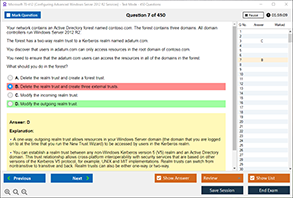Overview of the CompTIA Security+ SY0-701 Exam
The CompTIA Security+ SY0-701 exam is one of the most respected and widely recognized cybersecurity certifications available today. This certification serves as a foundational credential for professionals aiming to build a career in information security. As cyber threats grow more sophisticated and prevalent, understanding the fundamental principles of security has never been more essential.
The SY0-701 exam covers a wide array of security topics, including threat management, cryptography, identity and access management, risk mitigation, and more. A key topic within this certification is understanding the mechanisms of data handling, specifically file deletion and data destruction, which are crucial for maintaining data confidentiality and ensuring compliance with privacy regulations.
DumpsBoss provides expertly crafted resources tailored for the CompTIA Security+ SY0-701 exam, including real exam dumps, practice questions, and comprehensive study guides. These materials help candidates not only learn the theory but also understand the real-world application of security practices, including proper data deletion techniques.
Understanding File Deletion Basics
File deletion is a common operation in any computing environment, whether in personal, enterprise, or cloud-based systems. However, the basics of file deletion are often misunderstood. When a file is "deleted" from a system, it is typically not removed entirely. Instead, the system marks the space that the file occupied as available for future data. Until this space is overwritten by new data, the original file can still be recovered using specialized software.
For example, when you delete a file from your Windows operating system and empty the Recycle Bin, the file is no longer visible to the user. However, the actual data remains on the disk. This characteristic of file deletion creates a significant security risk if sensitive information falls into the wrong hands.
In the context of the SY0-701 exam, understanding how file systems operate and how data persists even after deletion is critical. DumpsBoss resources provide in-depth explanations and real-world scenarios to reinforce this important concept.
Common Methods of File Deletion
There are several methods used to delete files, each varying in effectiveness and security. Here are the most common approaches:
-
Standard Deletion (User-Level Deletion)
-
This is the most basic method, involving deleting a file using the operating system's default delete function (e.g., moving a file to the Recycle Bin or Trash).
-
While simple, it offers no real security as the file remains recoverable.
-
-
Formatting
-
Formatting a disk removes the file allocation table (FAT) or master file table (MFT), essentially rendering files inaccessible through normal means.
-
However, data recovery tools can often restore this data unless a full overwrite occurs.
-
-
Overwriting
-
A more secure method involves overwriting the file's storage location with random data, making recovery extremely difficult.
-
Tools like SDelete (from Microsoft Sysinternals) or DBAN (Darik's Boot and Nuke) are commonly used.
-
-
File Shredding
-
File shredding software not only deletes a file but overwrites its storage location multiple times with random patterns.
-
This technique is a good compromise between usability and data security.
-
-
Secure Erasure Commands
-
Operating systems and hardware often support secure erase commands (e.g., ATA Secure Erase), which can clear all data on a storage device.
-
These commands are designed to meet industry standards for data sanitation.
-
Each of these methods has its strengths and limitations, and understanding their nuances is essential for any aspiring security professional.
The Only Reliable Method: Data Destruction
While the above methods improve file deletion security, the only truly reliable method of ensuring that data is gone for good is physical data destruction. This involves physically destroying the media on which data is stored, rendering it unreadable and irretrievable.
Common physical destruction techniques include:
-
Degaussing
-
This process uses a high-powered magnet to disrupt the magnetic fields on a storage device.
-
It is effective on magnetic media like hard drives and tapes.
-
-
Shredding
-
Specialized shredders can reduce hard drives and storage media to small fragments, eliminating the possibility of reconstruction.
-
-
Drilling or Crushing
-
Drilling holes through hard drives or using hydraulic presses to crush them is another effective form of destruction.
-
-
Incineration
-
Though less commonly used due to environmental and safety concerns, incineration involves burning the storage device until it is completely destroyed.
-
For highly sensitive data, such as government or financial records, physical destruction is often mandated by compliance laws and standards. For SY0-701 exam takers, understanding the scenarios that necessitate physical destruction is essential.
Secure Erasure vs. Physical Destruction
While both secure erasure and physical destruction aim to prevent unauthorized data recovery, they differ significantly in approach and application. Here's a comparison:
| Feature | Secure Erasure | Physical Destruction |
|---|---|---|
| Method | Software-based (overwriting) | Hardware-based (destruction) |
| Reusability | Device may be reused | Device cannot be reused |
| Cost | Lower (software tools are often free) | Higher (requires specialized equipment) |
| Environmental Impact | Low | High (waste disposal issues) |
| Security Level | High, but not absolute | Absolute, especially when certified |
Industry Standards and Best Practices
Various organizations have defined standards and best practices for secure file deletion and media destruction. These guidelines ensure that sensitive data is irrecoverable and compliance is maintained.
-
NIST SP 800-88 Rev. 1
-
The National Institute of Standards and Technology provides comprehensive guidelines on media sanitization.
-
Defines Clear, Purge, and Destroy methods for different media types.
-
-
DoD 5220.22-M
-
The U.S. Department of Defense standard outlines multi-pass overwriting techniques to securely erase data.
-
-
ISO/IEC 27040
-
Offers guidelines for storage security, including secure deletion and disposal.
-
-
HIPAA and GDPR Compliance
-
Regulations like HIPAA and GDPR require organizations to properly dispose of data containing personal or health information.
-
Failure to do so can result in significant penalties.
-
Best Practices for Secure File Deletion and Destruction
-
Always identify the sensitivity level of data before choosing a deletion method.
-
Use certified tools and follow compliance frameworks (e.g., NIST SP 800-88).
-
For highly sensitive or regulated data, opt for physical destruction.
-
Implement organization-wide data destruction policies and training.
-
Verify and document the destruction process for auditing and compliance.
Conclusion
Understanding file deletion and data destruction is a crucial skill for anyone preparing for the CompTIA Security+ SY0-701 exam. From standard deletions to physical destruction, each method has its use case, limitations, and implications. Knowing when and how to apply these methods not only helps in passing the exam but also prepares candidates for real-world security challenges.
DumpsBoss plays a vital role in helping candidates master these topics by offering expert-reviewed exam dumps, detailed guides, and realistic practice tests. With the support of DumpsBoss, aspirants can confidently approach the SY0-701 exam, equipped with the knowledge and skills needed to excel in the cybersecurity field.
Choosing DumpsBoss as your exam preparation partner ensures you're not just studying for the exam, but truly understanding the essence of cybersecurity. Whether you're just starting your IT journey or looking to validate your experience, DumpsBoss provides the tools you need to succeed.
Special Discount: Offer Valid For Limited Time “CompTIA SY0-701 Dumps” Order Now!
Sample Questions for CompTIA SY0-701 Exam Dumps
Actual exam question from CompTIA SY0-701 Exam.
What is the only way of ensuring that deleted files on your computer are irrecoverable?
A) Emptying the Recycle Bin
B) Using the Shift + Delete command
C) Formatting the hard drive
D) Using secure file deletion or data-wiping tools



